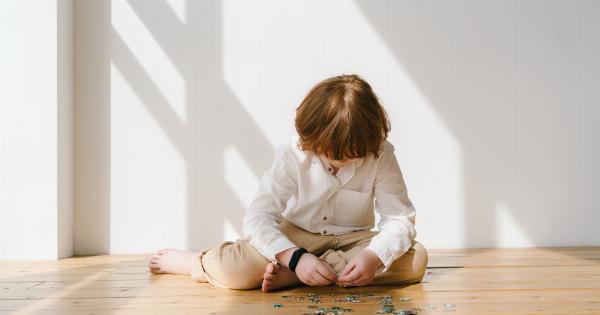Autism spectrum disorder (ASD) is a developmental disorder that affects communication, social interaction, and behavior. It typically appears in early childhood, often between the ages of 1 and 2 years.
Early identification and intervention are crucial for children with autism, as it can greatly improve their outcomes. This article focuses on red flags or early warning signs of autism in two-year-olds, helping parents and caregivers recognize potential symptoms and seek appropriate support.
1. Communication Difficulties
One of the key indicators of autism in two-year-olds is the presence of communication difficulties. These can manifest in various ways, including:.
- Lack of or limited speech: Two-year-olds with autism may have a vocabulary that is significantly smaller than their peers or may not speak at all.
- Delayed language development: They might struggle to combine words or use simple phrases appropriately for their age.
- Poor eye contact: Children with autism may avoid making eye contact during interactions.
- Difficulty understanding and following instructions: They may have trouble comprehending and responding to verbal cues.
2. Impaired Social Interaction
Children with autism often exhibit challenges in social interaction and may display the following red flags:.
- Lack of interest in playing with others: Two-year-olds with autism may prefer to play alone, showing limited interest in interacting with their peers.
- Difficulty initiating or responding to social cues: They may struggle to initiate or reciprocate greetings, gestures, or other forms of communication.
- Lack of imitation: They might have difficulty imitating others’ actions or behavior, such as clapping or waving goodbye.
- Trouble understanding emotions: Children with autism may struggle to understand and express their own emotions or to interpret other people’s feelings.
3. Repetitive Behavior and Restricted Interests
Another set of red flags for autism in two-year-olds includes repetitive behavior patterns and intense focus on specific interests. Some examples include:.
- Stereotyped movements: Two-year-olds may engage in repetitive behaviors such as hand-flapping, spinning, or rocking.
- Resistance to change: Children with autism often exhibit extreme distress or resistance to changes in routines or environments.
- Intense fixation on specific objects or topics: They may become excessively preoccupied with certain objects, activities, or subjects, displaying a narrow range of interests.
- Ritualistic behaviors: Two-year-olds with autism may adhere strictly to specific rituals or routines throughout their day.
4. Sensory Sensitivities
Many children with autism have an altered perception of sensory input, resulting in sensory sensitivities. These can appear as:.
- Hypersensitivity to certain sounds, lights, textures, or smells: Two-year-olds with autism might become overwhelmed or distressed by everyday sensory stimuli.
- Hypo-sensitivity to sensory input: Conversely, some children may show reduced sensitivity, seeking excessive sensory input like spinning in circles or toe-walking.
5. Delayed Motor Skills
Children with autism might display delays in motor skills development, including both fine and gross motor skills. Some indicators include:.
- Difficulty with fine motor tasks: They may struggle with activities such as holding a pencil, stacking blocks, or using utensils.
- Challenges with gross motor skills: Two-year-olds might have trouble with activities that involve running, jumping, or climbing.
- Peculiar movements or unusual posture: Children with autism may exhibit repetitive or unusual movements and may maintain atypical postures.
6. Regression or Loss of Skills
Occasionally, children who were previously meeting typical developmental milestones may experience a regression in their skills. This can be a red flag for autism and might be observed as:.
- Loss of previously acquired language skills.
- Decreased interest in social interaction or playing with others.
- Repetitive behaviors or stereotyped movements emerging for the first time.
7. Unusual Sensory Interests
Children with autism may exhibit fascination or fascination with certain sensory stimuli. Some common examples include:.
- Frequent inspection or focus on objects’ visual characteristics, such as spinning wheels or reflective surfaces.
- Intense fascination with sounds, such as the hum of a fan or repetitive vocalizations.
- Persistent interest in the texture or feel of specific materials, such as rubbing or scratching certain fabrics.
- Unusual fascination with smells or tastes, such as sniffing objects or licking non-food items.
8. Lack of Pretend Play
Two-year-olds with autism may exhibit limited or nonexistent pretend play skills. They might struggle to engage in imaginative play scenarios, such as pretending to feed a doll or talking on a toy phone.
9. Unresponsiveness to Name
Children with autism may appear unresponsive or not react when their name is called. They might not consistently turn their head or make eye contact when their name is called, which can be an early warning sign at the age of two years.
10. Difficulty with Transitions
Two-year-olds with autism may find transitions challenging and exhibit behaviors such as:.
- Meltdowns or tantrums when transitioning between activities or environments.
- Difficulty adapting to changes in routine or schedule.
- Resistance to transitions, needing additional time or support to shift from one task to another.
Conclusion
Recognizing early red flags of autism in two-year-olds is essential for early intervention and support.
If you notice multiple signs mentioned above, consulting with a healthcare professional or seeking an evaluation from a developmental specialist is recommended. Although these red flags indicate potential autism symptoms, an official diagnosis can only be made by qualified professionals after a thorough assessment.



























